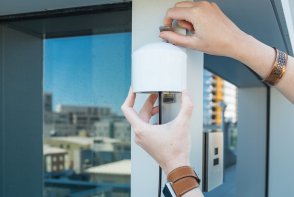Low-Cost Air Quality Sensors
What are low-cost air quality sensors?
Low-cost air quality sensors are a relatively new technology that measure specific air pollutants, typically particulate matter and occasionally gaseous pollutants, and cost much less than traditional air quality monitors. In the United States, air quality has traditionally been measured according to a metrics established by the United States Environmental Protection Agency (EPA) using equipment that implement a federal reference method (FRM) or federal equivalent method (FEM). These monitors cost tens of thousands of dollars and require significant infrastructure and trained personnel to operate. Low cost sensors may only cost a few hundred dollars. Low-cost sensors are increasingly popular with citizen scientists and community groups to help track air quality conditions in communities without monitoring or to supplement existing monitoring. The challenge is the interpretation of sensor data. Since these sensors are compact and inexpensively built, the data may vary from regulatory monitors.The Great Basin Unified Air Pollution Control District maintains a large network of ambient air quality monitors that utilize federal reference or equivalent methods. These monitors are approved by the EPA to help determine if the National Ambient Air Quality Standard for criteria pollutants are being achieved or exceeded. These monitors are regularly maintained, independently audited, and have high standards for quality assurance and quality control. Data from these monitors are held to rigorous review through multiple levels of checks and validation. Low-cost sensor data, on the other hand, are not approved by the EPA for comparison to the federal air quality standards due to the nature of the low-cost manufacturing and varying sensor responses.
Low cost sensors cannot replace traditional regulatory monitors, but they do create new opportunities to increase and expand access to air quality monitoring and can play a part in tracking air quality in the Eastern Sierra. The Great Basin Unified Air Pollution Control District received a grant from the California Air Resources Board to deploy a network of Purple Air low-cost sensors throughout Inyo, Mono, and Alpine Counties. These sensors will provide particulate matter (PM) data for smoke and dust in communities without regulatory monitors. The data will be particularly useful during wildfire season, providing a much better representation of smoke plume concentrations and distribution.
How do sensor data compare to regulatory data?
Most studies comparing Purple Air sensors to regulatory monitors have found Purple Air sensors report higher than regulatory monitors, sometimes twice as high. Recognizing this discrepancy, Purple Air has added the ability to apply "Conversion" factors to their website map. This option is in the lower left corner of the Purple Air map. By applying a conversion factor, the Purple Air map may show PM values closer to those of regulatory monitors, but since the studies to-date are few and far between, more research is needed. If you have any questions about low-cost sensors and how they are used in Inyo, Mono, or Alpine Counties, please contact us.
